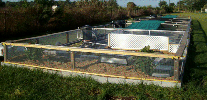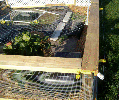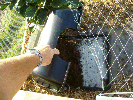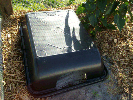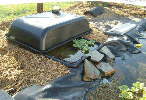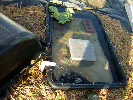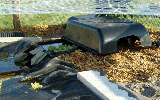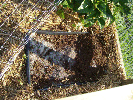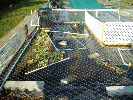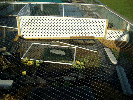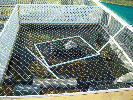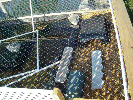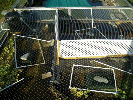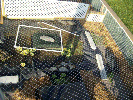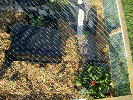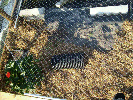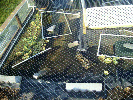Spotted pond
|
The enire enclosure is 16’ X 18’, with the area outlined by cinder blocks, and used some landscaping timbers to build up breaks to separate water areas. I made 3 separate ponds with one 10’ X 10’ pond liner. I sectioned off one of the small ponds to separate turtles if needed.
I covered the pond with netting to keep out large birds (we have heard of hawks eating adult spotteds). The ponds are enclosed with ¼” hardwire cloth mesh to keep the turtles in and everything else out. Also there is a electric fence wire around the top edge to keep the crawling animals out (cats, raccoons, dogs, ect.) Each pond has a small mixing tub with indoor outdoor carpeting on it attached to 4 bricks, to serve as a basking platform and a hide box. There are 2 small mixing tubs with sand and peat moss mixture for nesting areas (hopefully females will lay there). Also there are mixing tubs turned upside down with notches cut out, to serve as land area hide boxes. One large mixing tub is set up with water in it, feed by overflow from the filter, which feeds into one of the ponds. This tub is partially covered by another tub, and has play sand at the bottom, and lined with a plastic fencing (1/4” holes), so they can easily climb out. I have the same filter on it that I put on other ponds, but have it set up so that the pump is in one of the small ponds, and the filter outputs water into the large one, which then flows to one of the small ones, when then flows into the last one with the pump in it. The pump has a wire mesh pre filter screen on it also to keep from sucking up turtles and fish. The floating pvc sticks are to help keep the floating plants from all ending up in the last pond, breaking up the water flow movement in the ponds. the sqare pvc areas are keept mostly clear of plants, for an area to throw in floating food (if the food sets on top of the plants, the turtles can't eat it). |
